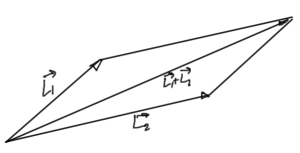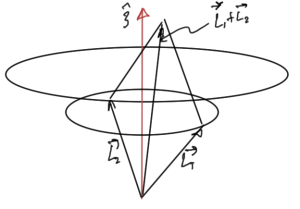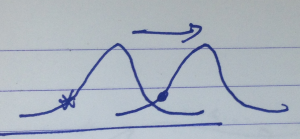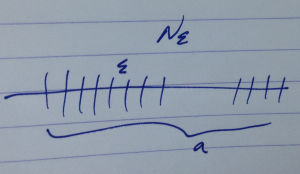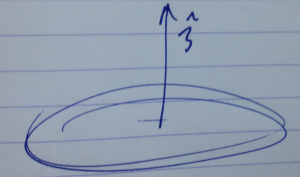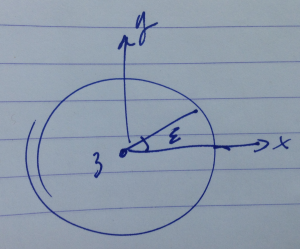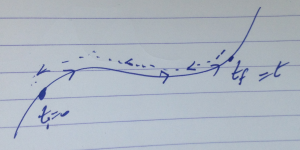[Click here for a PDF of this post with nicer formatting]
Q: [1] pr. 5.4
Given a 2D SHO with Hamiltonian
\begin{equation}\label{eqn:2dHarmonicOscillatorXYPerturbation:20}
H_0 = \inv{2m} \lr{ p_x^2 + p_y^2 } + \frac{m \omega^2}{2} \lr{ x^2 + y^2 },
\end{equation}
- (a)
What are the energies and degeneracies of the three lowest states? - (b)
With perturbation\begin{equation}\label{eqn:2dHarmonicOscillatorXYPerturbation:40}
V = m \omega^2 x y,
\end{equation}calculate the first order energy perturbations and the zeroth order perturbed states.
- (c)
Solve the \( H_0 + \delta V \) problem exactly, and compare.
A: part (a)
Recall that we have
\begin{equation}\label{eqn:2dHarmonicOscillatorXYPerturbation:60}
H \ket{n_1, n_2} =
\Hbar\omega
\lr{
n_1 + n_2 + 1
}
\ket{n_1, n_2},
\end{equation}
So the three lowest energy states are \( \ket{0,0}, \ket{1,0}, \ket{0,1} \) with energies \( \Hbar \omega, 2 \Hbar \omega, 2 \Hbar \omega \) respectively (with a two fold degeneracy for the second two energy eigenkets).
A: part (b)
Consider the action of \( x y \) on the \( \beta = \setlr{ \ket{0,0}, \ket{1,0}, \ket{0,1} } \) subspace. Those are
\begin{equation}\label{eqn:2dHarmonicOscillatorXYPerturbation:200}
\begin{aligned}
x y \ket{0,0}
&=
\frac{x_0^2}{2} \lr{ a + a^\dagger } \lr{ b + b^\dagger } \ket{0,0} \\
&=
\frac{x_0^2}{2} \lr{ b + b^\dagger } \ket{1,0} \\
&=
\frac{x_0^2}{2} \ket{1,1}.
\end{aligned}
\end{equation}
\begin{equation}\label{eqn:2dHarmonicOscillatorXYPerturbation:220}
\begin{aligned}
x y \ket{1, 0}
&=
\frac{x_0^2}{2} \lr{ a + a^\dagger } \lr{ b + b^\dagger } \ket{1,0} \\
&=
\frac{x_0^2}{2} \lr{ a + a^\dagger } \ket{1,1} \\
&=
\frac{x_0^2}{2} \lr{ \ket{0,1} + \sqrt{2} \ket{2,1} } .
\end{aligned}
\end{equation}
\begin{equation}\label{eqn:2dHarmonicOscillatorXYPerturbation:240}
\begin{aligned}
x y \ket{0, 1}
&=
\frac{x_0^2}{2} \lr{ a + a^\dagger } \lr{ b + b^\dagger } \ket{0,1} \\
&=
\frac{x_0^2}{2} \lr{ b + b^\dagger } \ket{1,1} \\
&=
\frac{x_0^2}{2} \lr{ \ket{1,0} + \sqrt{2} \ket{1,2} }.
\end{aligned}
\end{equation}
The matrix representation of \( m \omega^2 x y \) with respect to the subspace spanned by basis \( \beta \) above is
\begin{equation}\label{eqn:2dHarmonicOscillatorXYPerturbation:260}
x y
\sim
\inv{2} \Hbar \omega
\begin{bmatrix}
0 & 0 & 0 \\
0 & 0 & 1 \\
0 & 1 & 0 \\
\end{bmatrix}.
\end{equation}
This diagonalizes with
\begin{equation}\label{eqn:2dHarmonicOscillatorXYPerturbation:300}
U
=
\begin{bmatrix}
1 & 0 \\
0 & \tilde{U}
\end{bmatrix}
\end{equation}
\begin{equation}\label{eqn:2dHarmonicOscillatorXYPerturbation:320}
\tilde{U}
=
\inv{\sqrt{2}}
\begin{bmatrix}
1 & 1 \\
1 & -1 \\
\end{bmatrix}
\end{equation}
\begin{equation}\label{eqn:2dHarmonicOscillatorXYPerturbation:340}
D =
\inv{2} \Hbar \omega
\begin{bmatrix}
0 & 0 & 0 \\
0 & 1 & 0 \\
0 & 0 & -1 \\
\end{bmatrix}
\end{equation}
\begin{equation}\label{eqn:2dHarmonicOscillatorXYPerturbation:360}
x y = U D U^\dagger = U D U.
\end{equation}
The unperturbed Hamiltonian in the original basis is
\begin{equation}\label{eqn:2dHarmonicOscillatorXYPerturbation:380}
H_0
=
\Hbar \omega
\begin{bmatrix}
1 & 0 \\
0 & 2 I
\end{bmatrix},
\end{equation}
So the transformation to the diagonal \( x y \) basis leaves the initial Hamiltonian unaltered
\begin{equation}\label{eqn:2dHarmonicOscillatorXYPerturbation:400}
\begin{aligned}
H_0′
&= U^\dagger H_0 U \\
&=
\Hbar \omega
\begin{bmatrix}
1 & 0 \\
0 & \tilde{U} 2 I \tilde{U}
\end{bmatrix} \\
&=
\Hbar \omega
\begin{bmatrix}
1 & 0 \\
0 & 2 I
\end{bmatrix}.
\end{aligned}
\end{equation}
Now we can compute the first order energy shifts almost by inspection. Writing the new basis as \( \beta’ = \setlr{ \ket{0}, \ket{1}, \ket{2} } \) those energy shifts are just the diagonal elements from the \( x y \) operators matrix representation
\begin{equation}\label{eqn:2dHarmonicOscillatorXYPerturbation:420}
\begin{aligned}
E^{{(1)}}_0 &= \bra{0} V \ket{0} = 0 \\
E^{{(1)}}_1 &= \bra{1} V \ket{1} = \inv{2} \Hbar \omega \\
E^{{(1)}}_2 &= \bra{2} V \ket{2} = -\inv{2} \Hbar \omega.
\end{aligned}
\end{equation}
The new energies are
\begin{equation}\label{eqn:2dHarmonicOscillatorXYPerturbation:440}
\begin{aligned}
E_0 &\rightarrow \Hbar \omega \\
E_1 &\rightarrow \Hbar \omega \lr{ 2 + \delta/2 } \\
E_2 &\rightarrow \Hbar \omega \lr{ 2 – \delta/2 }.
\end{aligned}
\end{equation}
A: part (c)
For the exact solution, it’s possible to rotate the coordinate system in a way that kills the explicit \( x y \) term of the perturbation. That we could do this for \( x, y \) operators wasn’t obvious to me, but after doing so (and rotating the momentum operators the same way) the new operators still have the required commutators. Let
\begin{equation}\label{eqn:2dHarmonicOscillatorXYPerturbation:80}
\begin{aligned}
\begin{bmatrix}
u \\
v
\end{bmatrix}
&=
\begin{bmatrix}
\cos\theta & \sin\theta \\
-\sin\theta & \cos\theta
\end{bmatrix}
\begin{bmatrix}
x \\
y
\end{bmatrix} \\
&=
\begin{bmatrix}
x \cos\theta + y \sin\theta \\
-x \sin\theta + y \cos\theta
\end{bmatrix}.
\end{aligned}
\end{equation}
Similarly, for the momentum operators, let
\begin{equation}\label{eqn:2dHarmonicOscillatorXYPerturbation:100}
\begin{aligned}
\begin{bmatrix}
p_u \\
p_v
\end{bmatrix}
&=
\begin{bmatrix}
\cos\theta & \sin\theta \\
-\sin\theta & \cos\theta
\end{bmatrix}
\begin{bmatrix}
p_x \\
p_y
\end{bmatrix} \\
&=
\begin{bmatrix}
p_x \cos\theta + p_y \sin\theta \\
-p_x \sin\theta + p_y \cos\theta
\end{bmatrix}.
\end{aligned}
\end{equation}
For the commutators of the new operators we have
\begin{equation}\label{eqn:2dHarmonicOscillatorXYPerturbation:120}
\begin{aligned}
\antisymmetric{u}{p_u}
&=
\antisymmetric{x \cos\theta + y \sin\theta}{p_x \cos\theta + p_y \sin\theta} \\
&=
\antisymmetric{x}{p_x} \cos^2\theta + \antisymmetric{y}{p_y} \sin^2\theta \\
&=
i \Hbar \lr{ \cos^2\theta + \sin^2\theta } \\
&=
i\Hbar.
\end{aligned}
\end{equation}
\begin{equation}\label{eqn:2dHarmonicOscillatorXYPerturbation:140}
\begin{aligned}
\antisymmetric{v}{p_v}
&=
\antisymmetric{-x \sin\theta + y \cos\theta}{-p_x \sin\theta + p_y \cos\theta} \\
&=
\antisymmetric{x}{p_x} \sin^2\theta + \antisymmetric{y}{p_y} \cos^2\theta \\
&=
i \Hbar.
\end{aligned}
\end{equation}
\begin{equation}\label{eqn:2dHarmonicOscillatorXYPerturbation:160}
\begin{aligned}
\antisymmetric{u}{p_v}
&=
\antisymmetric{x \cos\theta + y \sin\theta}{-p_x \sin\theta + p_y \cos\theta} \\
&= \cos\theta \sin\theta \lr{ -\antisymmetric{x}{p_x} + \antisymmetric{y}{p_p} } \\
&=
0.
\end{aligned}
\end{equation}
\begin{equation}\label{eqn:2dHarmonicOscillatorXYPerturbation:180}
\begin{aligned}
\antisymmetric{v}{p_u}
&=
\antisymmetric{-x \sin\theta + y \cos\theta}{p_x \cos\theta + p_y \sin\theta} \\
&= \cos\theta \sin\theta \lr{ -\antisymmetric{x}{p_x} + \antisymmetric{y}{p_p} } \\
&=
0.
\end{aligned}
\end{equation}
We see that the new operators are canonical conjugate as required. For this problem, we just want a 45 degree rotation, with
\begin{equation}\label{eqn:2dHarmonicOscillatorXYPerturbation:460}
\begin{aligned}
x &= \inv{\sqrt{2}} \lr{ u + v } \\
y &= \inv{\sqrt{2}} \lr{ u – v }.
\end{aligned}
\end{equation}
We have
\begin{equation}\label{eqn:2dHarmonicOscillatorXYPerturbation:480}
\begin{aligned}
x^2 + y^2
&=
\inv{2} \lr{ (u+v)^2 + (u-v)^2 } \\
&=
\inv{2} \lr{ 2 u^2 + 2 v^2 + 2 u v – 2 u v } \\
&=
u^2 + v^2,
\end{aligned}
\end{equation}
\begin{equation}\label{eqn:2dHarmonicOscillatorXYPerturbation:500}
\begin{aligned}
p_x^2 + p_y^2
&=
\inv{2} \lr{ (p_u+p_v)^2 + (p_u-p_v)^2 } \\
&=
\inv{2} \lr{ 2 p_u^2 + 2 p_v^2 + 2 p_u p_v – 2 p_u p_v } \\
&=
p_u^2 + p_v^2,
\end{aligned}
\end{equation}
and
\begin{equation}\label{eqn:2dHarmonicOscillatorXYPerturbation:520}
\begin{aligned}
x y
&=
\inv{2} \lr{ (u+v)(u-v) } \\
&=
\inv{2} \lr{ u^2 – v^2 }.
\end{aligned}
\end{equation}
The perturbed Hamiltonian is
\begin{equation}\label{eqn:2dHarmonicOscillatorXYPerturbation:540}
\begin{aligned}
H_0 + \delta V
&=
\inv{2m} \lr{ p_u^2 + p_v^2 }
+ \inv{2} m \omega^2 \lr{ u^2 + v^2 + \delta u^2 – \delta v^2 } \\
&=
\inv{2m} \lr{ p_u^2 + p_v^2 }
+ \inv{2} m \omega^2 \lr{ u^2(1 + \delta) + v^2 (1 – \delta) }.
\end{aligned}
\end{equation}
In this coordinate system, the corresponding eigensystem is
\begin{equation}\label{eqn:2dHarmonicOscillatorXYPerturbation:560}
H \ket{n_1, n_2}
= \Hbar \omega \lr{ 1 + n_1 \sqrt{1 + \delta} + n_2 \sqrt{ 1 – \delta } } \ket{n_1, n_2}.
\end{equation}
For small \( \delta \)
\begin{equation}\label{eqn:2dHarmonicOscillatorXYPerturbation:580}
n_1 \sqrt{1 + \delta} + n_2 \sqrt{ 1 – \delta }
\approx
n_1 + n_2
+ \inv{2} n_1 \delta
– \inv{2} n_2 \delta,
\end{equation}
so
\begin{equation}\label{eqn:2dHarmonicOscillatorXYPerturbation:600}
H \ket{n_1, n_2}
\approx \Hbar \omega \lr{ 1 + n_1 + n_2 + \inv{2} n_1 \delta – \inv{2} n_2 \delta
} \ket{n_1, n_2}.
\end{equation}
The lowest order perturbed energy levels are
\begin{equation}\label{eqn:2dHarmonicOscillatorXYPerturbation:620}
\ket{0,0} \rightarrow \Hbar \omega
\end{equation}
\begin{equation}\label{eqn:2dHarmonicOscillatorXYPerturbation:640}
\ket{1,0} \rightarrow \Hbar \omega \lr{ 2 + \inv{2} \delta }
\end{equation}
\begin{equation}\label{eqn:2dHarmonicOscillatorXYPerturbation:660}
\ket{0,1} \rightarrow \Hbar \omega \lr{ 2 – \inv{2} \delta }
\end{equation}
The degeneracy of the \( \ket{0,1}, \ket{1,0} \) states has been split, and to first order match the zeroth order perturbation result.
References
[1] Jun John Sakurai and Jim J Napolitano. Modern quantum mechanics. Pearson Higher Ed, 2014.
